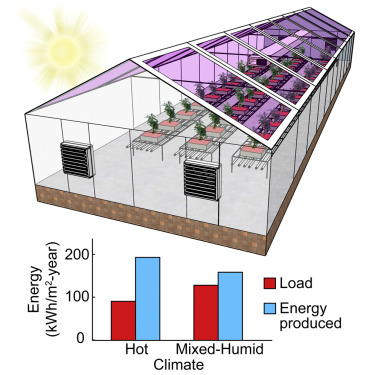Next Generation of Greenhouses May Be Fully Solar Powered
Many greenhouses could become energy neutral by using see-through solar panels to harvest energy – primarily from the wavelengths of light that plants don’t use for photosynthesis. Those are the findings of a new modeling study conducted by engineering, plant biology and physics researchers at North Carolina State University.

“Plants only use some wavelengths of light for photosynthesis, and the idea is to create greenhouses that make energy from that unused light while allowing most of the photosynthetic band of light to pass through,” says Brendan O’Connor, corresponding author of the study and an associate professor of mechanical and aerospace engineering at NC State. “We’re able to do this by using organic solar cells, because they allow us to tune the spectrum of light that the solar cell absorbs – so we can focus on using mostly wavelengths of light that plants don’t use. However, until now it wasn’t clear how much energy a greenhouse could capture if it was using these semitransparent, wavelength selective, organic solar cells.”
To address that question, researchers used a computational model to estimate how much energy a greenhouse could produce if it had semitransparent organic solar cells on its roof – and whether that would be enough energy to offset the amount of energy the greenhouse required to operate effectively. The model was developed to estimate energy use for greenhouses growing tomatoes at locations in Arizona, North Carolina and Wisconsin.
“A lot of the energy use in greenhouses comes from heating and cooling, so our model focused on calculating the energy load needed to maintain the optimal temperature range for tomato growth,” O’Connor says. “The model also calculated the amount of energy a greenhouse would produce at each location when solar cells were placed on its roof.”
The modeling is complex because there’s a complicated trade-off between the amount of power the solar cells generate and the amount of light in the photosynthetic band that they allow to pass through. Basically, if growers are willing to sacrifice larger amounts of photosynthetic growth, they can generate more power.
What’s more, the solar cells used for this analysis are effective insulators, because they reflect infrared light. This helps to keep greenhouses cooler in the summer, while trapping more warmth in the winter.
The end result is that, for many greenhouse operators, the trade-off could be a small one. Particularly for greenhouses in warm or temperate climates.
For example, in Arizona, the greenhouses could become energy neutral – requiring no outside source of power – while blocking only 10% of the photosynthetic band of light. However, if growers are willing to block more photosynthetic light, they could generate twice as much energy as they required to operate the greenhouse. In North Carolina, a greenhouse could become energy neutral while blocking 20% of the photosynthetic light. In Wisconsin, greenhouses couldn’t become energy neutral using the semitransparent solar cells – keeping the greenhouse warm in winter requires too much energy. However, the solar cells could meet up to 46% of the greenhouse’s energy demand.
“While the technology does use some of the light plants rely on, we think the impact will be negligible on plant growth – and that the trade-off will make financial sense to growers,” O’Connor says.
The paper, “Achieving Net Zero Energy Greenhouses by Integrating Semitransparent Organic Solar Cells,” is published in the journal Joule. First author of the paper is Eshwar Ravishankar, a Ph.D. student at NC State. The paper was co-authored by Ronald Booth, a Ph.D. student at NC State; Carole Saravitz, director of the NC State University Phytotron; Heike Sederoff, professor of plant and microbial biology at NC State; and Harald Ade, Goodnight Innovation Distinguished Professor of Physics at NC State. The work was done with funding from the National Science Foundation, under grant number 1639429.
Comments (0)
This post does not have any comments. Be the first to leave a comment below.
Featured Product

